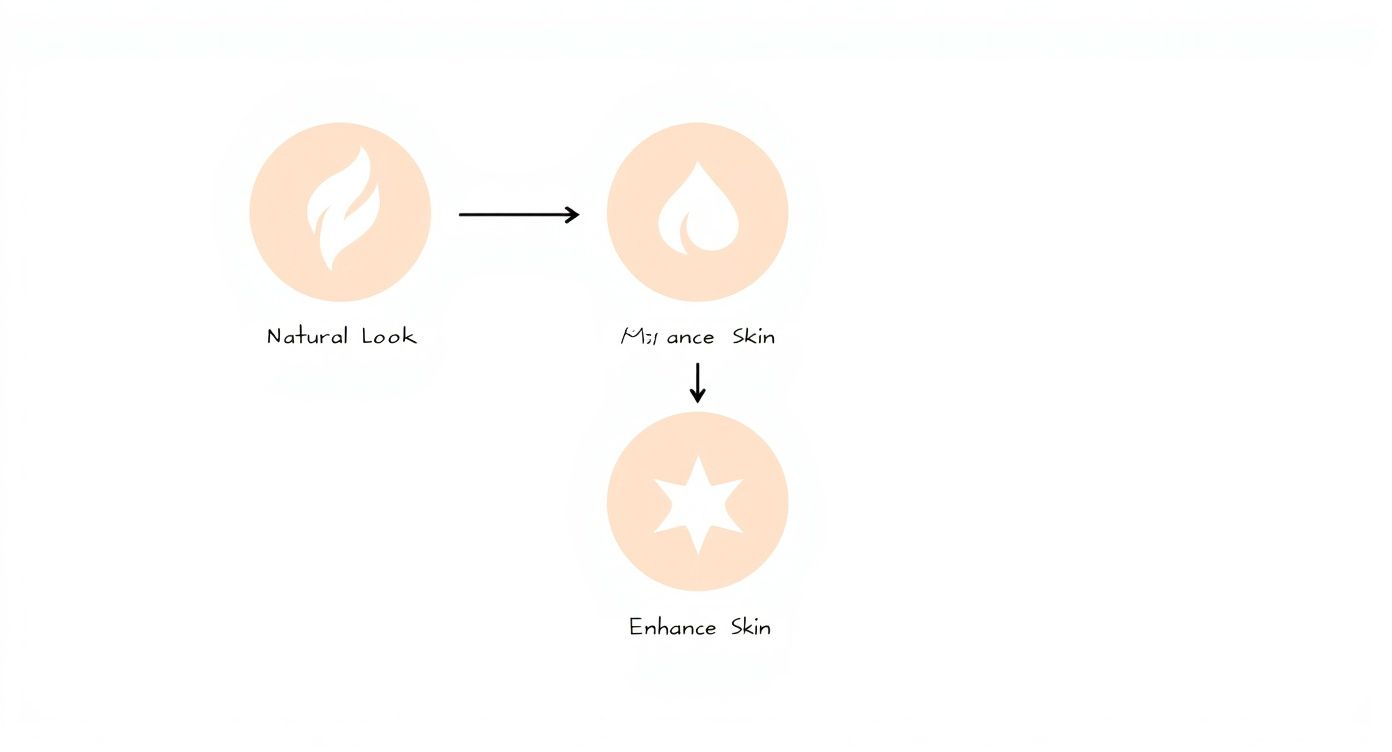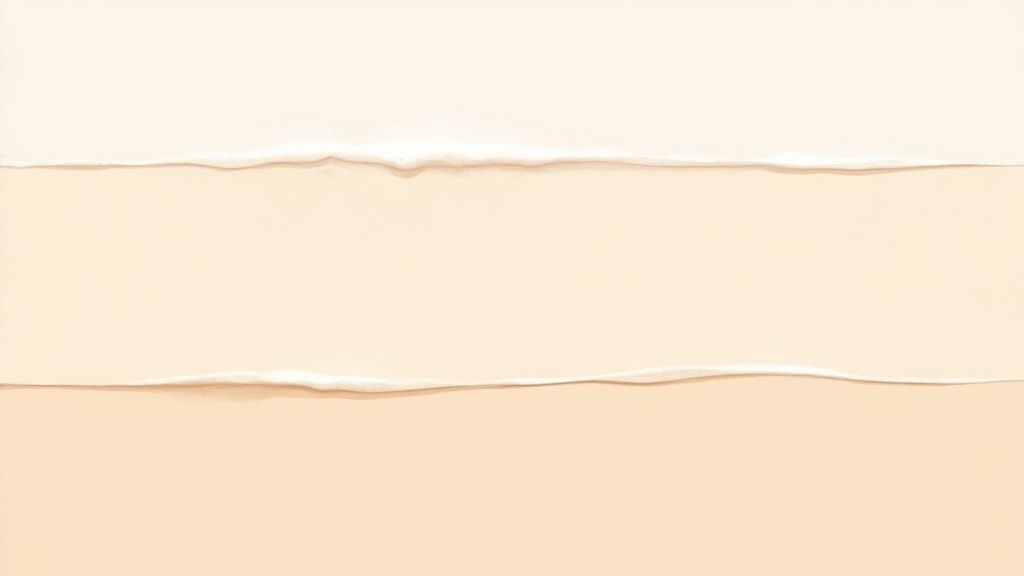If you're on the hunt for the best lightweight foundation, you're probably looking for something that feels like absolutely nothing on your skin. We're talking about those dreamy serum foundations and hydrating skin tints that give you that "your skin but better" vibe everyone is after.
So, Why Is Lightweight Foundation the Secret to Flawless Skin?
Tired of that heavy, cakey feeling that comes with traditional foundation? You're in the right place. The real magic of a good lightweight foundation isn't just about sheer coverage; it's about finding a formula that lets your skin breathe and actually enhances what you've got, instead of just covering it all up. It's a whole philosophy centered on comfort and radiance.
These days, the best lightweight formulas are so much more than just makeup. They’re often skincare-makeup hybrids, packed with good stuff that benefits your skin every time you put them on. Think of it as the last step of your skincare routine, but one that also perfects your complexion.
More Than Just Coverage
When we say "lightweight," we're really talking about the feel and texture on your skin. These foundations are made to be so comfortable you can wear them all day and completely forget they're there. The first thing I usually hear from friends who try one is, "I can't even feel this on my skin," even while they're admiring the visible improvement.
This whole category covers a few different types of products you've probably seen around:
- Serum Foundations: These are often loaded with active ingredients like hyaluronic acid or niacinamide. They basically treat your skin while giving you a light, dewy coverage. Win-win.
- Skin Tints: If you're going for a true minimal makeup look, tints are your best friend. They offer the sheerest touch of coverage, just enough to subtly even out any redness or discoloration.
- Buildable Formulas: A lot of the best lightweight options let you add a little more product where you need it—like under your eyes or around your nose—without ever getting heavy or cakey.
The goal here is a seamless finish that looks and feels like a second skin. It’s about letting your real skin—freckles and all—shine through, just a little more perfected.
Ultimately, choosing a lightweight foundation is about embracing the idea that makeup should work with your skin, not against it. It's all about getting that healthy, radiant look that feels as good as it looks, giving you that effortless, put-together confidence.
Match Your Foundation to Your Unique Skin Type
Okay, let's get one thing straight: choosing the best lightweight foundation starts with knowing your skin. It’s the one step you absolutely can’t skip. A formula that gives my dry-skinned friend a gorgeous, dewy glow would probably slide right off my oily T-zone by lunchtime.
Think of it like this: your skin has its own personality. Is it consistently shiny by noon? You’re likely in the oily skin club. Does it feel tight and thirsty, maybe even a little flaky, after you wash your face? That’s dry skin talking.
And, of course, many of us are a little bit of both—an oily T-zone with drier cheeks is classic combination skin. If your skin gets red and angry at the mere suggestion of a new product, you’ve got sensitive skin. Figuring this out is the real secret to a flawless finish.
Finding Your Formula
For my friends with oily skin, the goal is to keep that shine in check without caking on heavy products. You’ll want to hunt for oil-free formulas that promise a natural matte or soft satin finish. These are brilliant at managing excess oil so your makeup looks fresh, not greasy, by the end of the day.
If you have dry skin, your number one priority is hydration. You need a foundation that feels more like a moisturizer, one that adds a radiant, dewy finish. Look for hero ingredients like hyaluronic acid, glycerin, or squalane—they plump up the skin and stop the makeup from settling into fine lines.
Choosing the right foundation is less about hiding your skin and more about working with it. When the formula complements your skin's natural behavior, you get a seamless look that actually feels good to wear all day.
Dealing with combination skin is all about finding that perfect balance. You need something that can hydrate the dry spots without making your oily areas look like a disco ball. Buildable formulas are your best friend here—you can apply a sheer layer over oily zones and add a little more coverage where you need it.
Finally, for my sensitive skin folks, the ingredient list is everything. Stick to formulas that are fragrance-free, non-comedogenic (meaning they won’t clog pores), and hypoallergenic. Mineral-based foundations are often a really safe bet.
For a deeper dive into how the pros figure this all out, it's interesting to look into the esthetician client consultation process and see how they analyze skin needs.
This decision tree is a great way to visualize the process.

It all comes down to what you want from your foundation. Are you going for a minimal, "my-skin-but-better" vibe, or do you want a formula that pulls double duty with some bonus skincare benefits? Once you know that, you're on the right track.
Picking Your Perfect Coverage and Finish
When people hear "lightweight," they often think "invisible," but that’s not the whole story. The best lightweight foundations actually offer a whole world of possibilities. It’s all about striking that perfect balance between the coverage you want and the finish you love. This is where your personal style really gets to shine.

First up: coverage. This isn’t about masking your skin; it's about making it look its best. What’s your goal for the day? If you just want a whisper of color to even out a little redness and let your freckles pop, a sheer formula is your new best friend.
A lot of great lightweight options also offer buildable coverage, which is a total game-changer. This puts you in the driver's seat. You can start with one light layer for an easy, natural vibe, then tap a little extra onto specific spots—like around your nose or over a blemish—without ever feeling caked-on.
Find a Finish You Love
Once you've got your coverage figured out, it's time to think about the finish—how the foundation actually looks on your skin after it sets. This one choice can completely change your makeup look and often comes down to what your skin type needs.
You'll usually run into three main types of finishes:
- Dewy Finish: This one gives you that luminous, just-had-a-facial glow. It’s fantastic for anyone with dry or dull skin because it catches the light and creates an illusion of major hydration.
- Satin Finish: Consider this the happy medium. It’s not as shiny as dewy, but not as flat as matte. It just leaves behind a natural, healthy-looking radiance that looks like real skin, making it super versatile for most people.
- Natural Matte Finish: Modern matte isn’t the chalky, dry look of the past. It’s more of a soft-focus, velvety texture that’s amazing at keeping shine in check. If you have oily or combination skin, this is probably your jam.
To help you sort through it all, here's a quick cheat sheet.
Lightweight Foundation Finish and Coverage Guide
This table breaks down the different lightweight foundation finishes and coverage levels to help you find the perfect match for your skin and the look you're going for.
| Finish Type | Best For Skin Type | Coverage Level | Common Ingredients |
|---|---|---|---|
| Dewy | Dry, Mature, Dull | Sheer to Light | Hyaluronic acid, glycerin, squalane, luminous pearls |
| Satin | Normal, Combination | Light to Medium | Dimethicone, jojoba oil, vitamin E |
| Natural Matte | Oily, Combination | Medium to Buildable | Kaolin clay, silica, bamboo powder |
Remember, this is just a starting point. The real magic happens when you pair the right coverage with the right finish for you.
Think of a sheer, dewy foundation for that fresh, glowing look, or a buildable satin formula for a polished-but-natural vibe that's perfect for the office.
If you're after something super sheer and glowy, you might want to explore the world of tinted moisturizers. You can check out some of the best clean tinted moisturizer formulas out there—they often pack in skincare benefits with a barely-there, dewy finish.
Ultimately, it all boils down to what you like. Don't be afraid to play around and see what makes you feel the most confident in your own skin.
Decoding the Ingredient List for Skincare Benefits
Let's be real, the best lightweight foundations these days are basically skincare in disguise. Reading an ingredient label isn't just about dodging things that might irritate your skin anymore. It’s about finding those powerhouse ingredients that are actively doing good stuff for your face all day long.
This isn’t just a niche thing, either. It’s a huge shift in how we think about makeup.
The demand for makeup that moonlights as skincare is a pretty big deal in the cosmetics world. In fact, the global liquid foundation market is expected to hit $7.48 billion in 2025, and a lot of that growth is coming from people like us who want our foundation to do more than just cover up. We want it to improve our skin.
What to Look For and What to Avoid
When you're scanning that tiny print on the back of the bottle, a few key players should make you pause. Ingredients like hyaluronic acid are amazing for pulling moisture into the skin, giving you that plump, hydrated glow we’re all after. Niacinamide is another hero, famous for brightening skin and making pores look smaller over time. And obviously, SPF is a total non-negotiable for any daytime product.
Knowing what to steer clear of is just as crucial. If your skin is on the drier side, certain alcohols (like denatured alcohol) can be super stripping and are best avoided. For anyone with oily or acne-prone skin, heavy oils and ingredients that clog pores are a no-go. A good rule of thumb? Look for foundations that are labeled “non-comedogenic.” If you want to get into the nitty-gritty, we have a helpful guide on choosing non-comedogenic makeup products.
Your foundation sits on your skin for hours. Choosing one with beneficial ingredients turns that wear-time into an extended treatment, making your skin healthier with every application.
Getting familiar with how skincare actives work can really change the game. Understanding how active ingredients like glycolic acid work, for instance, gives you a better eye for what to look for in skincare-infused makeup. When you know what these ingredients do, you can pick a foundation that truly cares for your complexion.
Mastering Your Foundation Application Technique
You’ve found the perfect lightweight foundation—awesome. But that’s really only half the battle. How you put it on makes all the difference if you’re going for that flawless, second-skin finish.
The right technique is what helps your foundation melt into your skin, so it looks natural and seamless instead of just sitting on top. Before you even pick up a brush or sponge, though, make sure you start with a clean, moisturized canvas. It’s a non-negotiable for a smooth application.

Your choice of tool seriously impacts the final look. Each one gives a unique finish, so it’s worth playing around to see what works best for you and your go-to formula.
-
Fingers: This is a fantastic method for warming up serum or cream-based foundations. The heat from your fingertips helps the product blend effortlessly, creating a super natural, sheer finish. Just be sure to tap, not rub, to keep things streak-free.
-
Sponges: A damp makeup sponge is your best friend for an airbrushed, dewy effect. It gently presses the foundation into the skin while soaking up any excess, which is key to preventing a heavy or cakey look. For a full breakdown, you can learn more about how to apply foundation with a sponge.
-
Brushes: If you want more control or need to build coverage, grab a densely packed buffing brush. Use small, circular motions to buff the product in for an even, polished look.
Pro Tips for a Flawless Finish
To really nail your application, think about building coverage strategically. Always start with a tiny amount of product in the center of your face and blend outwards. This simple trick prevents that heavy, obvious foundation line around your hairline and jaw.
Need more coverage on certain spots, like blemishes or redness? Don't just slap on another full layer. Instead, use a small concealer brush or even your ring finger to gently tap a bit more foundation only where you need it.
The real secret is to work in thin layers. It’s always easier to add more product than it is to take it away. This method ensures your skin looks perfected, not masked, and lets your natural complexion shine right through.
Your Lightweight Foundation Questions, Answered
Even when you think you’ve got it all figured out, a few last-minute questions always seem to pop up. It happens to all of us. Let's tackle some of the most common ones so you can feel totally confident in your choice.
How Do I Find My Perfect Shade?
This is the million-dollar question, isn't it? But finding your match doesn't have to be a guessing game.
The golden rule is to always test swatches on your jawline or chest—never your hand! The skin there is a much truer match to your face. Let the swatch sit and dry completely, because some formulas oxidize and get a little darker after a few minutes.
Thankfully, technology is on our side now. A lot of brands offer AI and AR tools for virtual try-ons, making it way easier to find a good match from your couch. This is a huge reason why more people are buying foundation online, a trend highlighted in this global makeup foundation market report. If you're really stuck between two shades, it’s usually best to go with the slightly lighter one. You can always warm it up with a bit of bronzer.
Can Lightweight Foundation Actually Cover Acne and Redness?
Yes, it absolutely can. The key is to look for a formula that says it's "buildable." That’s your green light for layering coverage exactly where you need it, without things getting heavy or cakey.
Start with one sheer layer all over your face to even out your skin tone. Then, take a small, dense brush (or even just your fingertip) and gently tap a second layer only on the spots that need a little extra help. This spot-concealing trick is a game-changer; it hides what you want to hide while letting the rest of your skin breathe and look fresh.
A common reaction from people trying a lightweight formula for the first time is, "I can't even feel this on my skin," even as they see the visible coverage. It’s all about smart application, not heavy product.
What's the Real Difference Between a Skin Tint and a Serum Foundation?
It really boils down to two things: how much coverage you want and what kind of skincare benefits you're looking for.
-
A skin tint gives you the sheerest, most minimal coverage possible. Think of it as your skin, but better. Its main job is to subtly even out your complexion for that barely-there, natural look.
-
A serum foundation, on the other hand, is a true hybrid. It’s still lightweight, but it’s packed with a higher dose of active skincare ingredients, like vitamin C or hyaluronic acid. It’s basically treating your skin while providing light to medium coverage that you can often build up.
At Axiology, we believe makeup should feel just as good as it looks. Discover our skin-renewing, mushroom-infused Fungdation for a finish that’s both flawless and feather-light. Explore all our vegan, cruelty-free, and zero-waste products at https://www.axiologybeauty.com.





